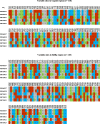Exploring the significant genetic diversity of Iranian isolates of Leishmania RNA virus 2 using whole genome sequence analysis
- PMID: 39695969
- PMCID: PMC11654432
- DOI: 10.1186/s12879-024-10194-6
Exploring the significant genetic diversity of Iranian isolates of Leishmania RNA virus 2 using whole genome sequence analysis
Abstract
Background: Our work presents the whole genome sequence and phylogenetic analysis of five Leishmania RNA virus 2 (LRV2) isolates obtained from patients with cutaneous leishmaniasis (CL) in Iran.
Methods: The whole genome sequencing of LRV2 was performed using a primer walking approach. The resulting sequences were analyzed for genetic and haplotype diversity, highlighting their independent evolution and significant genetic divergence.
Results: The whole genome sequence of the current LRV2 showed high genetic and haplotype diversity. The study also revealed the existence of three distinct clades of LRV2, with the LRV2 sequences infecting L. major, L. aethiopica, and sauroleishmania belonging to separate lineages. These lineages have seemingly evolved independently, as the geographic distribution of their flagellate hosts does not overlap with the Leishmania species. The divergence between these three clades is attributed to considerable antiquity, leading to genetic modifications within the viruses residing in them and resulting in structural differences in their genome.
Conclusions: These findings contribute to our understanding of the genetic diversity and evolution of LRVs, providing valuable insights into their role in Leishmania infections. Further investigations are needed to understand the significance of these polymorphic sites and their potential impact on viral characteristics and disease outcomes.
Keywords: Cutaneous leishmaniasis; Genetic diversity; Leishmania RNA virus 2; Primer walking; Whole genome sequence.
© 2024. The Author(s).
Conflict of interest statement
Declarations. Ethical approval and consent to participate: The current research was conducted with approval from the ethical principles and national regulations governing medical research (IR.MAZUMS.REC.1398.344). All experiments were performed in accordance with relevant guidelines and regulations. Informed written consent was obtained from adult participants and the parents of children, adhering to guidelines, and their responses were documented using a structured questionnaire. Consent for publication: Not applicable. Competing interests: The authors declare no competing interests.
Figures







Similar articles
-
First report of Leishmania RNA virus 2 and its high genetic diversity in cutaneous leishmaniasis cases from Ilam Province, Iran.BMC Med Genomics. 2025 Aug 21;18(1):135. doi: 10.1186/s12920-025-02198-1. BMC Med Genomics. 2025. PMID: 40842011 Free PMC article.
-
Presence and diversity of Leishmania RNA virus in an old zoonotic cutaneous leishmaniasis focus, northeastern Iran: haplotype and phylogenetic based approach.Int J Infect Dis. 2020 Dec;101:6-13. doi: 10.1016/j.ijid.2020.08.033. Epub 2020 Sep 15. Int J Infect Dis. 2020. PMID: 32947050
-
Unraveling the genetic diversity and phylogeny of Leishmania RNA virus 1 strains of infected Leishmania isolates circulating in French Guiana.PLoS Negl Trop Dis. 2017 Jul 17;11(7):e0005764. doi: 10.1371/journal.pntd.0005764. eCollection 2017 Jul. PLoS Negl Trop Dis. 2017. PMID: 28715422 Free PMC article.
-
Molecular identification of Leishmania RNA virus in cutaneous leishmaniasis patients and rodent reservoirs in Isfahan province, Iran.Infect Genet Evol. 2022 Mar;98:105222. doi: 10.1016/j.meegid.2022.105222. Epub 2022 Jan 20. Infect Genet Evol. 2022. PMID: 35066166
-
Molecular Diagnosis of Human Cutaneous Leishmaniasis and Identification of the Causative Leishmania Species in Iran: A Narrative Review.Iran Biomed J. 2024 Jul 1;28(4):148-55. doi: 10.61186/ibj.4239. Iran Biomed J. 2024. PMID: 39275812 Free PMC article. Review.
Cited by
-
First report of Leishmania RNA virus 2 and its high genetic diversity in cutaneous leishmaniasis cases from Ilam Province, Iran.BMC Med Genomics. 2025 Aug 21;18(1):135. doi: 10.1186/s12920-025-02198-1. BMC Med Genomics. 2025. PMID: 40842011 Free PMC article.
References
-
- Abadías-Granado I, Diago A, Cerro P, Palma-Ruiz A, Gilaberte Y. Cutaneous and mucocutaneous leishmaniasis. Actas Dermo Sifiliográficas (English Edition). 2021;112(7):601–18. - PubMed
-
- Saberi R, Fakhar M, Mohebali M, Anvari D, Gholami S. Global status of synchronizing Leishmania RNA virus in Leishmania parasites: a systematic review with meta-analysis. Transbound Emerg Dis. 2019;66(6):2244–51. - PubMed
MeSH terms
LinkOut - more resources
Full Text Sources

